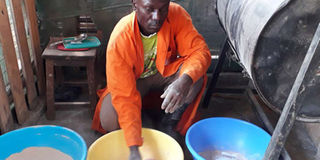Diary of a poultry farmer: Homemade feeds save you fortunes

A worker at Kienyeji Kenya Ltd mixes ingredients for making feeds. By formulating his own feeds, Dr Subiri Obwogo saves between Sh30 and 50 on every 70kg bag. PHOTO | COURTESY
What you need to know:
- I have always advised farmers like Samuel to consider formulating their own feeds at home as a way to control the cost and quality of feeds.
- There’s something else you need to know which is that the cost of feeds alone accounts for up to 70 per cent of the total cost of producing an egg or chicken meat.
- What bothers me most is that whenever the cost of raw materials for making feeds goes down, millers are reluctant to lower prices.
- The golden rule is that when you start to formulate your own feeds, test on a few birds for some weeks (or even months) and compare with a commercial ration to gauge the performance.
Last week, I travelled to Thika town which is 30 kilometres from my farm in Njiru to buy raw materials for making chicken feeds. I came back a happy farmer and I am sure you’re eager to know the reason.
The first thing I did when I got to the offices of the miller was to ask the lady at the reception the cost of maize germ. “A bag is retailing at Sh1,190,” she replied curtly.
I did some quick calculations and realised that they were selling a kilo at Sh20. Now, for the last six months or so, I’d been buying a kilo at Sh26.
With this reduction, I was going to save Sh6,000 for every tonne. If I use a tonne every month, it means by the end of this year, I’ll save Sh72,000.
There’s something else you need to know which is that the cost of feeds alone accounts for up to 70 per cent of the total cost of producing an egg or chicken meat.
As such, any savings I make from feeds automatically translates to my profits. When I make my own feeds, I save between 30 and 50 per cent on every 70 kg bag depending on the cost of raw materials.
But then, not all farmers will benefit from this reduction. As a matter of fact, if you’ve been reading newspapers, you’d know that the price of maize and maize meal is set to rise.
What bothers me most is that whenever the cost of raw materials for making feeds goes down, millers are reluctant to lower prices. However, when the cost goes up, they are always quick to transfer the burden to poor farmers citing “increased demand.”
You see, barely a week ago, I got email from Samuel Mungai, a poultry farmer from Gatanga. He was feeling the pinch of the escalating cost of feeds and I felt for him. “I keep about 550 layers but the cost of feeds is way too high,” he lamented. “Do you still hold classes on feed formulation at your farm?”
I then enquired how much a 70kg bag of layers mash costs him. I have summarised the calculations below for you to understand his dilemma and that of thousands of other small scale poultry farmers. The bottom line is that many poultry farmers simply work to profit the millers.
COMES WITH CHALLENGES
It’s more frustrating to know that barely a week ago, it was reported that brokers were flooding the local market with cheap maize imports from Uganda where a 90kg bag costs Sh1,800.
As this was going on, the National Cereals and Produce Board (NCPB) was offering Sh3,200 per 90kg bag of maize meaning that someone somewhere is making a kill from the market distortions.

Kienyeji Kenya Ltd's extrapolation of monthly gross margin for 550 exotic layer birds. PHOTO | COURTESY
What makes things worse is that local farmers who harvested their maize in November and December cannot sell their produce to NCPB because the government has no funds.
I have always advised farmers like Samuel to consider formulating their own feeds at home as a way to control the cost and quality of feeds.
However, making your own feeds comes with challenges. I have learnt that “poor outcomes on home-made rations can result from poor quality of raw materials, poor mixing or wrong choice of materials.”
At the same time, poor quality feeds leads to a slow growth in chickens, low egg production, diseases or even death.
From my experience, it takes patience and time to get it right. “Formulating feeds is both a science and an art, a lifelong journey subject to testing and experimentation,” my mentor, Dr Silas Obukosia, once cautioned me. “You’re misguided if you think that you’ll get it right on the first, second, third, or even fourth attempt.” (SoG Jul 23, 2016).
The golden rule is that when you start to formulate your own feeds, test on a few birds for some weeks (or even months) and compare with a commercial ration to gauge the performance.
It’s also important to occasionally test the raw materials and finished products in a laboratory to certify the quality.





